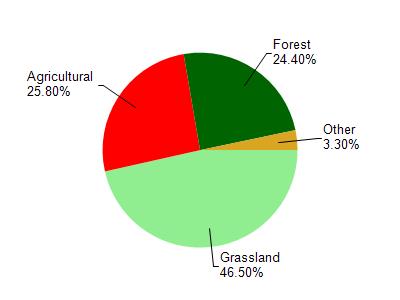Green, Iowa
No
No
No
Fish and Aquatic Life
Overview
This small warm water forage fishery begins in Green County and joins Brager Branch near the Iowa County line. Sampling conducted in 2002 showed only a few forage fish. The stream has decent bends, meanders and fairly stable banks, but fairly limited habitat (unpublished data). The small size of the stream probably prevents it from holding top level species such as trout
Date 2002
Author Aquatic Biologist
Historical Description
This very small, clear stream runs west and joins Brager Branch near the Iowa County line. The watershed is a narrow valley of pasture, cropland, and hardwood forest. The bottom is primarily sand and gravel, but minor erosion has caused some areas to become silted in. Aquatic vegetation is very scarce.
Forage species constitute the fishery with only creek chubs, brook sticklebacks and mottled sculpins being collected. Other species of forage fish undoubtedly come up periodically from Brager Branch. Wildlife values are negligible and public access consists of one town road crossing.
Fish Species: Creek chubs, brook stickleback, mottled sculpin. Surface Acres = 0.2, Length = 0.7 miles, Gradient = 35 ft./mi., Base Discharge = 0.7 cu. ft./sec
Bush, D.M., R. Cornelius, D. Engle, and C.L. Brynildson. 1980. Lake and Stream Classification Project. Surface Water Resources of Green County, 2nd Edition. Wisconsin Department of Natural Resources, Madison, Wisconsin.
Date 1980
Author Surface Water Inventory Of Wisconsin
Historical Description
McPeace Valley Creek - Mouth location T4N R5E Section 13 -10, Surface area = 0.3 acres, Length = 0.5 miles, Gradient = 40.0 feet per mile, Total alkalinity = 260.0 mg/l, Volume of flow = 1.8 cfs.
McPeace Valley Creek is a small seepage fed stream which begins in Green County and flows southwesterly into Blue Mounds Branch. It has a moderate gradient and over 85 percent of its drainage basin is cleared for agricultural uses. Flooding is not very common but bank erosion is still a serious problem. Less grazing would be a step to improve this situation. The lower section of stream has a sand bottom with few holes and therefore will only support forage fishes. Those species which can be found include bluntnose minnows, creek chubs, johnny darters, and sculpins. There are no public lands on this stream but it can be reached from a town road in Green Bay.
From: Piening, Ronald and Threinen, C.W., 1968. Lake and Stream Classification Project. Surface Water Resources of Iowa County, Wisconsin Department of Natural Resources, Madison, WI.
Date 1968
Author Surface Water Inventory Of Wisconsin
Historical Description
From: Poff, Ronald J., and C.W. Threinen, Lake and Stream Classification Project. Surface Water Resources of Green County, Wisconsin Conservation Department, Madison I, 1961.
Flows west into Lafayette County. Managed for forage fish. Cattle lane access; however, most of the stream is situated in unused pasture land. Good flow and abundant water cress.
Surface Acres= 1.7, Miles= 2.8, Gradient= 21.5' per mile
Date 1961
Author Surface Water Inventory Of Wisconsin
Condition
Wisconsin has over 84,000 miles of streams, 15,000 lakes and milllions of acres of wetlands. Assessing the condition of this vast amount of water is challenging. The state's water monitoring program uses a media-based, cross-program approach to analyze water condition. An updated monitoring strategy (2015-2020) is now available. Compliance with Clean Water Act fishable, swimmable standards are located in the Executive Summary of Water Condition in 2018. See also the 'monitoring and projects' tab.
Management Goals
Wisconsin's Water Quality Standards provide qualitative and quantitative goals for waters that are protective of Fishable, Swimmable conditions [Learn more]. Waters that do not meet water quality standards are considered impaired and restoration actions are planned and carried out until the water is once again fishable and swimmable
Management goals can include creation or implementation of a Total Maximum Daily Load analysis, a Nine Key Element Plan, or other restoration work, education and outreach and more. If specific recommendations exist for this water, they will be displayed below online.
Monitoring
Monitoring the condition of a river, stream, or lake includes gathering physical, chemical, biological, and habitat data. Comprehensive studies often gather all these parameters in great detail, while lighter assessment events will involve sampling physical, chemical and biological data such as macroinvertebrates. Aquatic macroinvertebrates and fish communities integrate watershed or catchment condition, providing great insight into overall ecosystem health. Chemical and habitat parameters tell researchers more about human induced problems including contaminated runoff, point source dischargers, or habitat issues that foster or limit the potential of aquatic communities to thrive in a given area. Wisconsin's Water Monitoring Strategy was recenty updated.
Grants and Management Projects
| Project Name (Click for Details) | Year Started |
|---|
|
|
Monitoring Projects
| WBIC | Official Waterbody Name | Station ID | Station Name | Earliest Fieldwork Date | Latest Fieldwork Date | View Station | View Data |
|---|
| 907700 | McPeace Valley Creek | 10009528 | Mcpeace Valley Creek at Buckeye/Sunnyside Rd | | | Map | Data |
|

Watershed Characteristics
McPeace Valley Creek is located in the Gordon Creek watershed which is 76.90 mi². Land use in the watershed is primarily grassland (46.50%), agricultural (25.80%) and a mix of forest (24.40%) and other uses (3.30%). This watershed has 205.79 stream miles, 7.11 lake acres and 487.25 wetland acres.
Nonpoint Source Characteristics
This watershed is ranked High for runoff impacts on streams, Not Ranked for runoff impacts on lakes and High for runoff impacts on groundwater and therefore has an overall rank of High. This value can be used in ranking the watershed or individual waterbodies for grant funding under state and county programs.However, all waters are affected by diffuse pollutant sources regardless of initial water quality. Applications for specific runoff projects under state or county grant programs may be pursued. For more information, go to surface water program grants.